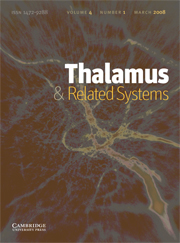Article contents
The developmental decrease in REM sleep
Published online by Cambridge University Press: 18 April 2006
Abstract
This mini-review considers certain factors related to the developmental decrease in rapid eye movement (REM) sleep, including its timing, its relationship to other developmental changes, factors that may influence its progress and its potential role in brain development. Specifically, we discuss some of the theories proposed for its occurrence and agree with the classic notion that REM sleep is, at least, an active mechanism that may play a role in the maturation of the central nervous system (CNS), specifically contributing to the maturation of thalamocortical pathways. The developmental decrease in REM sleep occurs gradually from birth until after puberty in the human, but in other mammals it is brief and coincides with eye and ear opening and the beginning of massive exogenous activation. This purported role for REM sleep may change to involve a number of other functions with age. We describe recent findings showing that intrinsic morphological and physiological properties as well as serotonergic, n-methyl-D-aspartic acid (NMDA) and kainic acid (KA) synaptic inputs to mesopontine cholinergic neurons change dramatically at this critical period in development, perhaps driving what has been proposed as a REM sleep inhibitory process (RIP). We hypothesize that a dysregulation of this process could result in life-long disturbances in REM sleep drive, leading to hypervigilance or hypovigilance such as that observed in a number of disorders which have a mostly postpubertal age of onset. Finally, we also hypothesize that the role of normal cyclic increases in vigilance, observable during both sleep and waking, may be related, at least in part, to cortical blood flow.
Keywords
Information
- Type
- Mini-review
- Information
- Copyright
- Elsevier Science Ltd
- 9
- Cited by

